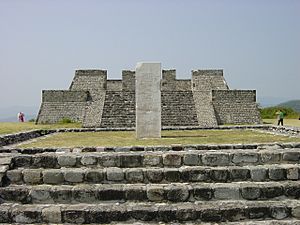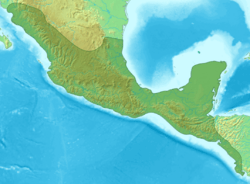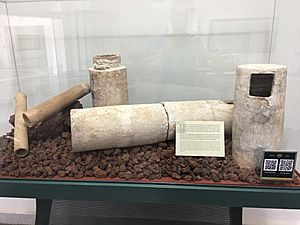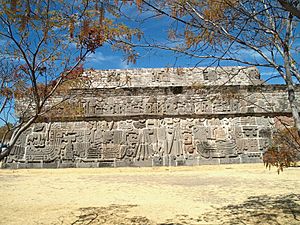Xochicalco facts for kids

Pyramids in Xochicalco
|
|
| Location | Miacatlán, Morelos, Mexico |
|---|---|
| Region | Mesoamerica |
| Coordinates | 18°48′14″N 99°17′45.3″W / 18.80389°N 99.295917°W |
| History | |
| Periods | Late Classic |
| Site notes | |
| UNESCO World Heritage Site | |
| Official name | Archaeological Monuments Zone of Xochicalco |
| Criteria | Cultural: iii, iv |
| Inscription | 1999 (23rd Session) |
| Area | 707.65 ha |
Xochicalco (pronounced "sho-chee-KAL-ko") is an amazing ancient city in Mexico. Its name means "in the house of Flowers" in the Nahuatl language. This special place is found in the western part of the Mexican state of Morelos. It's about 38 kilometers southwest of Cuernavaca.
Xochicalco was a very important city long ago, especially after the powerful city of Teotihuacan declined. Some people think Xochicalco might have even helped in Teotihuacan's fall. The buildings and art here show styles from Teotihuacan, the Maya civilization, and other cultures. Today, people in the nearby village of Cuentepec still speak Nahuatl.
The main part of Xochicalco sits on a hill that was flattened by people. There are also remains of houses on terraces down the slopes. People first lived here around 200 BC. But it became a big city between 700 and 900 AD. Most of the buildings you see today were built during this time. At its busiest, Xochicalco might have had up to 20,000 people living there.
Xochicalco is a UNESCO World Heritage Site, which means it's a very important place for everyone to protect. It's also a popular spot for tourists to visit. There's a great museum at the site where you can learn even more.
Contents
Exploring Xochicalco's Wonders
Xochicalco has many incredible buildings and sculptures. One of the most famous is the Temple of the Feathered Serpent. This temple has beautiful carvings of the Feathered Serpent god. These carvings mix styles from Teotihuacan and Maya art.
The pyramid's sides show pictures of towns that paid tribute to Xochicalco. They also feature seated figures that look like Maya people. Some experts believe that artists from all over Mesoamerica might have lived and worked in Xochicalco.
Other Amazing Structures
Besides the Feathered Serpent Temple, you can see other step-pyramid temples. There are also palaces, three ballcourts for playing ancient games, and even sweat-baths. A unique row of circular altars and a cave with carved steps are also here. Some carved stone slabs, called stelae, are on display at the site's museum. Others are in the INAH museum in Mexico City.
A Look Back in Time: History and Discovery
Xochicalco was founded around 650 AD by a group called the Olmeca-Xicalanca. These were traders from Campeche, a Mayan area. They chose this spot because it was perfect for controlling important trade routes. The city was home to 10,000 to 15,000 people. Many of them made crafts or traded goods over long distances.
It became an important city with strong defenses and a center for trade and religion. This happened after other big Mesoamerican cities started to decline. The land around Xochicalco wasn't great for farming. This suggests the city was built more for defense and trading than for growing food.
Who Discovered Xochicalco?
The ruins of Xochicalco were first written about by an explorer named Antonio Alzate in 1777. Later, in 1810, Alexander von Humboldt published a description and drawing of the site. Even Emperor Maximilian of Mexico visited the ruins.
Mexican archaeologist Leopoldo Batres restored the Temple of the Feathered Serpent in 1910. More big digs and restorations happened from the 1940s to the 1960s. Many archaeologists, like Kenneth Hirth, worked to map the entire site. They also excavated houses and workshops where people made tools from obsidian. In 1988, a large project began to dig up more of the grand buildings. A new museum was built to show off the amazing things they found.
Why Did Xochicalco End?
Around 900 CE, the city of Xochicalco was burned and destroyed. Many of the excavated houses and temples show signs of burning. This suggests the city was destroyed and abandoned very quickly. People left many objects behind in their homes.
A small group of people continued to live on the lower parts of the hill. Later, around 1200, new people moved in. These were the Nahuatl-speaking Tlahuica peoples. They are the ancestors of the Nahuatl-speaking people who live in the modern state of Morelos today.
Looking at the Stars: The Observatory
Xochicalco has a special observatory inside a cave. This cave was changed so people could study the sun's movement. The inside of the cave was covered with plaster and painted black, yellow, and red. A chimney, about 8.7 meters tall, goes from the cave floor to the surface. It has a hexagonal shape at the top.
The chimney has a slight slope. This allows the sun's rays to shine onto the cave floor. For 105 days each year, from April 30 to August 15, the sun shines into the cave. On May 14 or 15, and again on July 28 or 29, the sun is directly overhead. At noon on these days, a beam of light falls straight through the chimney. It creates an image of the sun on the cave floor. This amazing solar event was likely used for important religious ceremonies.
Images for kids
See also
- List of archaeoastronomical sites sorted by country
- List of Mesoamerican pyramids





